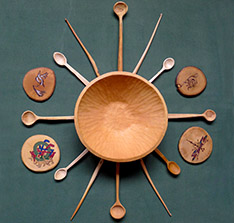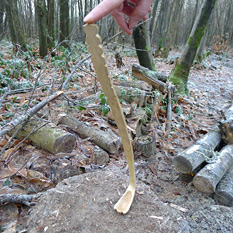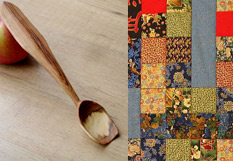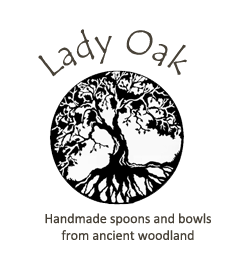



The Silver Birch is a delicate, feminine, tree and can be easily recognized by its distinctive silvery bark. This can be peeled from the trunk quite readily and can be put to many uses, such as firelighting, making baskets and containers, and can even be processed for use in medicines.
Birch is what is termed as a ‘colonizer’ tree and produces massive amounts of small light winged seed. This means that any area cleared within the woods, or land that has been laid waste by any means, tends to show an abundance of small Birch saplings growing after about one year. The tree can grow to a fair age, often with a very distinguished character, straight trees are almost unknown. However, unlike the Oak and Yew, Birch trees never achieve a great age. (what is the average age of a Birch tree?)
The wood is very good for small carvings such as spoons and small bowls. Birch burls are commonly carved to make ornate Sami kuksa's. The wood will rot after a couple years left on the ground becoming either soft and punky or if kept clear of the ground hard and brittle and therefore prone to snapping suddenly. This tendency to rot easily does have a very desirable attribute, that is the spalting the Birch will take on during this process of decay. Sometimes wonderfully decorated pieces can be found, but care needs to be taken that the wood is strong enough for purpose. Pieces like this can be used as knife handles or decorative spoons. Another use for the twigs is in the manufacture of Besom brooms and making woven babies cribs.
There is much lore and history surrounding the Hazel tree, from its use in water divining to its title as ‘The Tree of Knowledge’ and of ‘Poetic Inspiration’, the Hazel is a much loved native of Britain. The act of coppicing the Hazel can extend, or even double its lifespan, with the young ‘whips’ being ideal for making staffs, walking sticks and crooks. Its timber has many other uses such as in thatching, for making woven hurdles, baskets, furniture and firewood, while the edible leaves and fruits are an important food source for woodland wildlife.
Hazel is a good wood to carve, giving a beautiful smooth finish, gentle sheen and durability.
Another feminine tree and with a strong affinity to water, Willow likes to be near water rather than have its feet right in it. Willow has many different forms from the garden tree of a weeping willow to the short rotation coppice beds of basketry Willows grown for their colour and flexibilty. Willow is a very fast growing tree that can be cut again and again to produce fresh shoots. Willow has a tendency to stabilise any wet ground it grows on and its use on the Somerest levels amongst other places helped that area become more accessible.
Willow has many uses from the long slender stems used in the making of baskets to the variety bred exclusively for the manufacture of cricket bats. In a natural setting more often Goat willow is found and this can often be distinguished by the small diamonds imprinted in the bark of the tree. The two year old growth of this particular variety also contains a natural painkiller similar to Aspirin. Willow can be carved to make lovely spoons that are very light and often have a subtle darker streak in the heartwood.
The Sycamore is a naturalised tree of Britain, it is thought to have been introduced in the Middle Ages but some sources believe that could have been a native tree of Scotland in the Bronze Age but died out due to climate change.
The Sycamore is a fast growing tree which has a high tolerance to wind and urban pollution thus making it an ideal species for planting in towns and cities. However, it has been condemned as an invasive species and some conservationists believe it to be a threat to our native woodland species.
The wood is an off white colour, has a silky sheen and is very hardwearing. It has many uses from musical instruments, wooden flooring and kitchen utensils. It is a lovely wood to carve, and makes durable spoons and bowls which are functional and decorative.
Mountain Ash is a tree found generally in higher more remote places again a very feminine tree that produces large clumps of red berries in the Autmn. Rowan can grow in some very inaccessible places, finding nooks and ledges to sink its roots in to gorge edges and sheltered gullies on mountains.
The wood is different than the Ash tree with a much tighter grain and a bark that will shrivel and wrinkle when dry. The wood can make some lovely spoons if a piece large enough can be found.
A firey tree with a strong affinity with water Alder likes it feet in the wet stuff, often to be found growing along side stream and gills within woodlands. It is fast growing up to around 20 years then will slow down, can become quite massive often growing in a stool that over years will thin out to two or three stems. Alder is the only deciduous tree that produces cones in which are contained its tiny seeds. During the spring you can place your ear against an Alder tree and listen to the tree gulping up water.
When cut Alder will exude a reddish sap that will stain the wood an attractive orange/pink colour if worked soon enough after felling. Alder was used by the Vikings for bowls and drinking vessels, a more modern use is for making the soles of clogs which was the default footwear in this country for many people. Alder is an easy and forgiving wood to work with and always look attractive when finished.
Ash is a very tall tree that needs to stand above all others to really survive well, producing very little leaf compared to other species it is amazing the great clumps of seed, or keys, that can be found early in the year on Ash trees. Its Latin name Fraxinus Excelsior eludes to it regal nature, often dubbed the dubious honour of the king or queen of firewoods.
“Beechwood fires are bright and clear
If the logs are kept a year,
Chestnut's only good they say,
If for logs 'tis laid away.
Make a fire of Elder tree,
Death within your house will be;
But ash new or ash old,
Is fit for a queen with crown of goldBirch and fir logs burn too fast
Blaze up bright and do not last,
it is by the Irish said
Hawthorn bakes the sweetest bread.
Elm wood burns like churchyard mould,
E'en the very flames are cold
But ash green or ash brown
Is fit for a queen with golden crownPoplar gives a bitter smoke,
Fills your eyes and makes you choke,
Apple wood will scent your room
Pear wood smells like flowers in bloom
Oaken logs, if dry and old
keep away the winter's cold
But ash wet or ash dry
a king shall warm his slippers by. “The Firewood Poem by Lady Celia Congreve
Providing Ash is fast grown it produces an very strong resilient wood that is used traditionally as tool handles, spears and hockey sticks all because Ash can absorb shock. A more modern day use is in the frames of motor cars, traditionally the Morris Minor is well known as having an Ash frame, but also it is used within the frames of Morgan sports cars.
Very feminine with thorns to match, the Hawthorn is a hedgerow tree that can also be found growing within woodlands. Interestingly these Hawthorns do not have anywhere as many thorns as those grown in the hedgerows, showing that the growth of thorns is very much a reaction to the environment that the tree grows. Sometimes known as “bread and cheese” and this alludes to its edible properties. The young leaves can be eaten raw and when the berries ripen they too can be eaten.
The wood is very tightly grained and if a suitable piece can be found it can make lovely dense spoons that can be intricately carved to a crisp finish.
The Mighty Oak tree
Of you we build our dwellings
Of you we built a navy
Of you we steal your symbology
But really a debt of gratitude
We owe to thee.
Oak is steeped in history and lore, a very masculine tree of the summer time. There are two native Oaks to this coutry; English Oak and Sessile Oak, few are those that can tell the difference. The easiest way to tell is when the tree has its Acorns and the English Oak will have the cup for the Acorn on a stem called a penduncle, the Sessile will have its Acorns in a cup growing directly from the branch.
The uses of Oak trees need little introduction, so steeped is it wood in this countries consciousness, from Oak timber frame buildings to the ships of the English naval fleet. It is obvious that Oak is a strong building timber hat can last many years both in and out of water. While green it can be precisely worked to produce the necessary mortise and tenon joints used in building frames. It also makes excellent long lasting fencing that has distinctive character.
Another tree steeped in history and Lore, again a masculine tree this time of the Winter, Holly is a evergreen tree with prickly leaves that are edible for livestock and has red berries in the late Autumn. Coupled with the bright white of the wood this give us the three main colours of the winter season.
The aforementioned white wood is dense and close grained that makes lovely detailed carvings. The wood also has a distinctive green smell.



